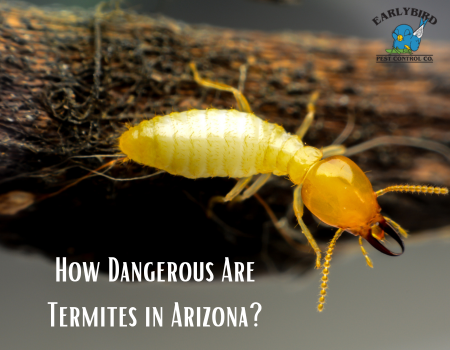Arizona is renowned for its dry, arid climate, stunning desert landscapes, and resilient wildlife. However, among the creatures that thrive in this environment, one particular pest stands out for the damage it can cause: the termite. These tiny, wood-eating insects may seem insignificant individually, but when they work together, termites can inflict costly damage to homes and buildings. Understanding how dangerous termites are in Arizona, especially in cities like Phoenix and Tucson, is essential for homeowners who want to protect their investments.
Types of Termites in Arizona
Arizona is home to three main types of termites: subterranean termites, drywood termites, and desert dampwood termites. Each of these species poses unique threats to homes and buildings, though some are more destructive than others.
- Subterranean Termites: Subterranean termites are the most common and destructive termite species in Arizona. These termites build underground colonies, which can house millions of individual termites. They require moisture to survive, which is why they create mud tubes to travel from the soil to a building’s wooden structures. Once inside a home, subterranean termites can consume wooden support beams, flooring, and even furniture, often leaving behind hollowed-out structures that can eventually lead to structural collapse. Their extensive underground colonies make them difficult to detect until significant damage has already been done.
- Drywood Termites: Drywood termites, unlike subterranean termites, can survive without needing contact with soil. They live and feed on dry wood, often entering a building through cracks in wooden structures or through exposed wood. This type of termite tends to cause slower damage compared to subterranean termites, but they are still a serious threat. Drywood termites can infest furniture, hardwood floors, and even the walls of your home. Signs of a drywood termite infestation include small piles of wood-colored fecal pellets near wooden structures or discarded wings near windowsills.
- Desert Dampwood Termites: Desert dampwood termites are less common in Arizona and generally prefer wood with a higher moisture content. While these termites are less likely to invade homes, they can still pose a threat, particularly in areas where wood is exposed to moisture, such as around leaking pipes, poorly ventilated crawl spaces, or in garden beds. Dampwood termites tend to infest decaying or dead wood, but under certain conditions, they can spread to homes and cause significant damage.
The Extent of Termite Damage
The dangers posed by these little pests are primarily financial rather than directly harmful to humans. Termites do not bite or transmit diseases; however, the destruction they cause can be immense and expensive. Nationwide, termites are responsible for more than $5 billion in property damage annually, and Arizona is one of the states where termite activity is particularly high due to its climate.
In Arizona, homes constructed with wood frames are especially vulnerable. These pests often go unnoticed for months or even years, as they usually work from the inside out. Homeowners might only discover an infestation once the damage is severe, with visible signs including:
- Buckling wood or floors
- Hollow-sounding walls
- Mud tubes on the foundation or around wooden structures
- Droppings or “frass” near infested areas
- Discarded wings near windows or doors
The damage that the termite cause can lead to costly repairs, structural insecurity, and, in some cases, the need to replace entire sections of a home. Regular inspections are key in detecting termite activity early, minimizing the potential for large-scale destruction.
Arizona’s Climate and Termite Activity
Arizona’s hot, dry climate plays a significant role in the high prevalence of termites. Subterranean and desert termites thrive in this environment, which provides them with ideal conditions for nesting and feeding. The monsoon season in Arizona, typically occurring between June and September, can also stimulate termite activity. Increased moisture during this period allows subterranean termites to expand their colonies and search for new sources of wood to feed on.
Because of these factors, Arizona homeowners need to be particularly vigilant, even if their homes are newer or built with treated wood. Over time, the protective treatments used on wood structures can wear off, making the home vulnerable to termite invasion.
Termites are a serious threat to Arizona homeowners, capable of causing extensive structural damage and financial strain. With the state’s climate providing ideal conditions for termite activity, it’s essential for homeowners to be proactive in preventing and addressing infestations. When you enlist the help of professionals like Early Bird Pest Control, you can safeguard your home from these destructive pests. Regular inspections, moisture control, and immediate treatment of any signs of termites can save you from costly repairs and ensure your home remains termite-free for years to come.


Recent Comments